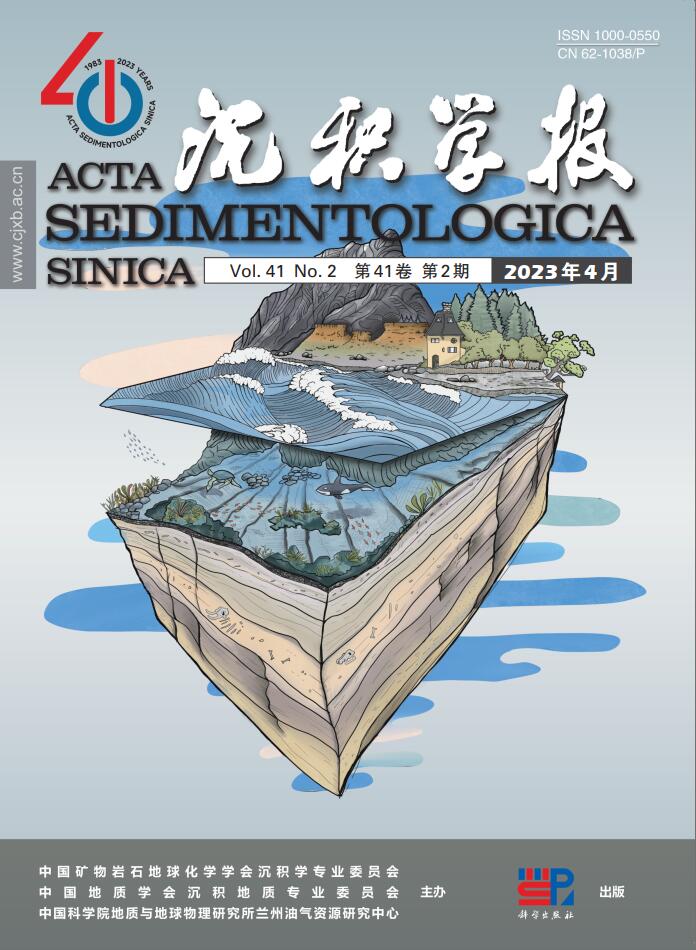HTML
-
软沉积物变形构造中记录了沉积物未固结时发生在沉积环境中的各种物理作用。这些变形构造可以为解释水动力条件、古斜坡方向和同沉积的地震和构造活动提供准确的信息[1⁃6]。当沉积物由于液化(liquefaction)和/或者流体化(fluidization)表现出类似液体的性质时,就会在驱动力的作用下发生变形。液化和流体化的触发因素主要包括地震、波浪、滑塌、地下水活动等作用[7⁃8]。
负载构造、球—枕构造、包卷层理、泄水构造等软沉积物变形构造类型在浊积岩沉积序列中非常普遍[5,9⁃11],通常被认为指示着快速沉积导致的液化和/或流体化[12⁃13]。其中负载构造是沉积物液化最重要的标志,因为这些构造是沉积物液化后在重力不稳定性的作用下,上覆密度较大的沉积物垂向下移而形成的[13]。上覆沉积物向下移动后,下伏密度较小的沉积物会向上挤入,形成火焰状或其他形态的挤入构造。沉积物主要垂直移动,挤入构造尖端的倾斜方向具有一定的随机性,通常不能指示古斜坡方向或古流向[14]。然而,当负载构造和由此形成的挤入构造的要素发生定向倾斜时,就说明有水平方向的力参与了构造的形成过程[13]。这种横向作用力的产生通常与流体的牵引、沉积物在斜坡上的重力分量[15]以及不均匀载荷有关[10]。
本文通过对灵山岛修船厂剖面中发育的负载—挤入构造、泄水—沉积物充填构造和微断层进行研究,观察并描述了其形态特征,分析了其成因机制,并对变形构造的要素发生定向倾斜的原因进行了解释,探讨了其在指示古流向方面的意义。
-
灵山岛位于山东省青岛市黄岛区(原胶南市)东南的黄海之中(图1),距最近的陆地大珠山约9.8 km,距青岛市约40.7 km。灵山岛海拔513.6 m,是中国北方的第一高岛,总面积约7.66 km2。灵山岛区域构造环境复杂且远离大陆,导致其大地构造背景、地层发育、沉积环境等长期存在争议。灵山岛是一座构造掀斜成因的小岛[16],在构造上位于苏鲁造山带中。苏鲁造山带是由华北克拉通和扬子克拉通在三叠纪的碰撞而形成的[17]。早白垩世,由于郯庐断裂带的左旋走滑,区域内的NE向断裂比较活跃[18]。同一时期,大陆强烈扩张,岩石圈减薄,在现今山东近海地区形成了一系列的裂陷盆地和中生代的浊积岩沉积[19]。钟建华等[20-21]在灵山岛莱阳群中发现了镜煤细层和炭化的植物碎屑[20]以及风暴沉积[21],提出这套地层形成于陆相环境;邵珠福等[22]结合沉积构造和岩性岩相组合研究,认为莱阳群是在陆内三角洲环境形成的,而不是深水环境,更不是海底斜坡;李守军等[23]在灵山岛下白垩统泥岩中发现了鱼类和叶肢介化石,认为这套地层属于陆相沉积;孟元库等[24]认为,早白垩世灵山岛地区为典型的断陷湖盆,沉积了一套较厚的湖相沉积。

Figure 1. Geographic location and geological setting of Lingshan Island[6]
在灵山岛出露的剖面中一共可识别出四个地层单元。最下部是一套浊积岩沉积序列,由灰绿色、灰黑色砂岩、粉砂岩和黑色、灰黑色泥岩或页岩互层组成,对应于早白垩世早中期的海相沉积,在时间上可对比于胶莱盆地的莱阳期沉积;其上覆盖了一层区域性展布的青山群灰白色流纹岩,厚度变化较大,在岛的南部最厚可达15~20 m,向北逐渐减薄至数米厚,可以作为地层对比的标志;这套流纹岩之上为一套青山群陆相沉积,整体表现为由下向上泥页岩所占比例逐渐减少,砂砾岩层比例逐渐增加,并夹有数套薄层辉绿岩侵入和火山碎屑流沉积,标志着区域性的构造抬升和逐渐活跃的火山活动;最上部的一个地层单元由厚层的青山群安山质火山碎屑岩和安山岩所组成[25]。
-
灵山岛的浊积岩主要出露在岛的西部和南部。由于这套沉积序列由薄层的细砂岩和黏土岩构成良好的韵律性,因此被认为符合海相复理石或远源浊积岩的特征[26]。张海春等[27]提出建立灵山岛组来代表这套浊积岩沉积序列,因为它与相邻的胶莱盆地内同时期沉积的莱阳期河湖相沉积有很大的不同。整体来看,这套浊积岩沉积序列主要由薄层的砂岩和平行层理的极薄层粉砂岩和泥岩互层形成的纹层组(或泥岩)组成。浊积岩相中发育的沟模和槽模指示古水流方向主要为SEE—NWW。
修船厂剖面位于灵山岛西侧中部的海边,整体呈近南北走向(图2a)。地层中滑塌构造发育(图2b),部分地层层理严重变形甚至被破坏,有向塑性流过渡的趋势(图2c)。整体由层面近似平行的多套浊积岩层组成,以细砂岩、粉砂岩和泥岩为主,每套浊积岩层对应一期浊流事件,厚度变化大,最小可小于1 cm,最大可达十几厘米。每套浊积岩层都由砂岩部分和纹层组(或泥岩)部分组成,对应浊流的二分性特征。砂岩部分对应浊流下部的高密度部分,通常表现出递变层理,沉积物粒度逐渐变细,一般是从细砂到极细砂,也可见中砂或粗砂到细砂和极细砂的变化。纹层组由平行排列的毫米级的粉砂纹层和小于1 mm的黏土纹层组成,由牵引加微粒沉降作用(traction plus fallout processes)形成。
-
本文所研究的软沉积物变形构造发育在修船厂剖面中部的一套浊积砂岩和粉砂—泥岩互层的纹层组之间(图3)。上覆的砂岩视厚度为10 cm左右,整体表现为粗砂到粉砂变化的正粒序层理,向上逐渐过渡为泥岩。下伏变形地层的粉砂岩和泥岩纹层的单层厚度为毫米级,整个纹层组厚度为15 cm左右。变形构造形成之后,地层受后期构造作用影响,整体发生滑塌褶皱。这套地层在南部发生褶皱,稍向北有一段未受影响地层,再向北逐渐消失。
-
浊积砂岩底部发育的负载构造多呈瘤状,形态、大小极不规则,宽度和高度变化范围为数毫米至数厘米。同生的挤入构造发育在负载构造之间,往往表现为穹顶状或火焰状,宽度和高度变化都在数毫米到1 cm之间。下伏纹层组只有上部纹层发生变形,下部纹层未发生变化(图4)。变形的纹层原生层理得以保存,只有层厚发生了一定的变化。具体表现为:在负载构造之下,纹层受到挤压厚度变薄,而向挤入构造的尖端方向,纹层组中的粉砂层逐渐变厚,泥质层厚度变化不大。统计变形构造的倾斜方向,发现负载构造绝大部分向观察层面的右侧倾斜,只有极小部分向相反方向倾斜;挤入构造大部分向观察层面的右侧倾斜,小部分向相反方向倾斜。部分变形构造倾斜方向相反,可能是负载构造的不均匀载荷压力造成的。
-
在上覆浊积砂岩中,发育了一系列的泄水—沉积物充填构造。由于差异风化,这些变形构造往往表现出内凹的形态,易于辨认,充填的沉积物也可直接观察。这些泄水—沉积物充填构造往往“植根”于下伏挤入构造的尖端,向上延伸,有的垂直于层面,但大部分向观察剖面的左侧倾斜,也有少数向右侧倾斜。在一些新鲜的露头上,可以明显地观察到泄水构造中充填的沉积物与下伏纹层组的沉积物性质相同。一些构造中,下伏纹层未发生破裂,充填沉积物可能来自下伏地层中最上部的纹层(图5);而在一些变形构造中,下伏纹层有多层发生破裂,泄水构造中充填的沉积物可能与这些破裂的纹层有关(图6)。这些变形构造都表现出向上刺穿砂岩,向上逐渐消失的特征。
-
在这套连续展布的地层中,还可以在下伏的纹层组中观察到一些微断层构造,表现为多个纹层发生破裂,层面不再连续,断面几乎垂直于岩石层面,垂向上发生一定的位移,断距通常只有几毫米(图6),有的还表现出向上和向下逐渐消失的特征。偶尔会有少数微断层,断面几乎切穿整个纹层组,断距可以达到2 cm(图7),断面向观察层面的右侧倾斜。
3.1. 负载—挤入构造
3.2. 泄水—沉积物充填构造
3.3. 微断层构造
-
软沉积物变形构造的变形机制主要是发生在无黏着力(cohesionless)沉积物(如砂砾岩等)中的液化(liquefaction)和流体化(fluidization)以及发生在有黏着力(cohesive)沉积物(如泥岩或页岩等)中的触变作用(thixotropy)[7,28]。由于颗粒咬合作用和颗粒之间摩擦力,无黏着力的沉积物具有一定的强度。
液化作用发生时,原来由颗粒支撑承担的上覆沉积物的重量带来的负载压力部分或全部转移到孔隙流体上,导致孔隙流体压力增加,沉积物强度大大减小甚至为零[7,28]。液化作用发生在封闭系统中,没有孔隙流体的增加或减少,沉积物颗粒的浓度与液化之前相比没有变化,颗粒的分离距离小于颗粒直径。
流体化作用发生在开放的系统中(图8),需要有流体连续流过沉积物颗粒,流体阻力的向上分力等于或者大于颗粒的重力[12⁃13]。表观流速是指岩层表面的流量与单位面积的比值。最小流体化速度是指流体阻力的向上分力正好等于颗粒重量,此时负载压力等于零,沉积物表现出黏性流体一样的性质。低值的表观流速代表着流体的渗流,在这种条件下,负载压力被流体阻力部分补偿,沉积物强度相应降低(图8a)。当表观流速超过最小流体化速度时,沉积物颗粒的分离距离增加,黏性减小。因此流体化意味着沉积物层体积的增加。如果表观流体速度超过沉积物颗粒的沉降速度,那么孔隙流体会发生流动(图8c),沉积物被淘洗,或者被随孔隙流体运移[7](图8d)。
本研究中,下伏纹层组中的粉砂层在变形过程中向挤入构造尖端方向流动,在泄水—沉积物充填构造中发生了流体的渗流(泥质层未破裂)与流体和颗粒的向上运移(泥质层发生破裂),因此软沉积物变形构造的变形机制主要为流体化。
-
沉积物在液化后,如果没有驱动力的存在,沉积物颗粒会发生再沉积(resedimentation),陆续沉淀下来,除排列更加紧密和部分颗粒在重力作用下发生定向排列外,不会发生变形,而且原始层理也会保存[28]。换言之,软沉积物变形是液化或流体化的沉积物在驱动力的作用下形成的。驱动力一般包括:1)斜坡上的重力分量;2)倒置密度梯度;3)不均匀负载;4)横向或纵向剪切力;5)生物或化学动力[7⁃8,28⁃29]。通过研究这些软沉积物变形构造的形态特征和形成过程,认为其形成与两个主要的驱动力系统有关,即倒置密度系统和横向剪切力系统,其中横向剪切力来源于浊流的流动。
-
软沉积物变形构造的变形机制和驱动力,在大部分情况下可以通过对变形构造本身特征研究来明确[29]。但是,触发因素的解释则相对困难得多,因为不同的触发因素可以引发相似形态的软沉积物变形构造,而同一种触发因素又可以形成不同形态的变形构造[10,30⁃31]。这导致识别复杂软沉积物变形构造的触发因素非常困难。前人提出了基于判别标准(criteria-based)的方法来识别地震触发因素,基于触发因素(trigger-based)的方法来识别非地震触发因素[28,32⁃36]。地震触发因素的判别标准一般有:1)横向上连续,纵向上反复出现且被未变形层相隔;2)可与已发现的地震成因变形构造形态相对比;3)沉积盆地构造活动活跃;4)变形构造的强度、复杂度和数量等围绕震中呈环带状递变分布[28]。对于非地震触发因素,Moretti et al.[35]曾提出通过一一分析所有的触发因素来进行识别,但是这种方法既不全面,也难以实现。因此,Owen et al.[28]提出了三步评价法,即结合沉积相评价、可能的触发因素评价和可用的判别标准评价来识别触发因素:1)沉积相评价:沉积相和软沉积物变形构造发育之间的关系决定了触发因素是内生(与沉积过程密切相关)还是外生(与沉积过程无关);2)触发因素评价:确定了触发因素是内生还是外生之后,就可以在小范围内进行一一评价,进一步厘清最可能的触发因素;3)判别标准评价:然后提出可用的判别标准,并评价其是否支持解释的触发因素。
利用这种方法对本研究中的变形构造的触发因素做出识别:1)这些变形构造发育在上覆浊积岩序列的砂岩和下伏浊积岩序列的纹层组之间,上覆浊积岩顶部的细粒沉积物未发生任何形变,说明变形构造不是在上覆浊积岩沉积之后由于地震等因素发生的,而是发生在上覆浊积岩沉积的过程中,否则上覆浊积岩的顶部不会没有受到任何影响。这种密切的关系说明变形构造的发育与沉积过程密切相关,外生的触发因素可以排除;2)在确定触发因素是与沉积过程密切相关(内生)之后,就需要对内生的触发因素一一评价。考虑到沉积环境的水深,波浪作用、潮汐作用、风暴作用等因素可以被排除,变形构造的形态特征也与地下水活动等形成的变形构造形态相差甚远,因此浊流的快速沉积就成为了最可能的触发因素;3)以上描述的几种变形构造的要素都有定向倾斜的特征,是在浊流带来的横向剪切力的作用下形成的,支持识别的触发因素。因此本研究的软沉积物变形构造的触发因素是浊流的快速沉积作用。
综上所述,软沉积物变形构造的形成过程为:前一期浊流沉积下来不久后,后一期浊流流动过来发生快速沉积,给下伏尚未完全固结的纹层组带来了载荷压力,使得其中的粉砂层发生液化和流体化,在负载构造的挤压下,向负载构造之间流动,形成挤入构造。纹层组在负载构造之下变薄,而向挤入构造的尖端方向逐渐变厚。在一些情况下,粉砂纹层中的孔隙流体压力很大,足以导致相邻泥质层的破裂,使得孔隙流体携带沉积物向上流动,形成泄水—沉积物充填构造。由于孔隙流体和沉积物通过的路径形成脆弱面,导致微断层的产生。浊流的流动带来的横向剪切力导致变形构造的要素发生定向倾斜,也和不均匀载荷共同导致了微断层断距的产生。
4.1. 变形机制
4.2. 驱动力
4.3. 触发因素
-
软沉积物变形构造要素的定向倾斜可以指示古流向,但是通常在野外观察到的剖面是二维的,而且并不是完全平行于变形构造倾斜的方向,所以观察到的倾斜方向不一定是真实的古流向。如图9所示,假设真实古流向为HG,如果剖面为HGO,那么测量得到的古流向恰好是真实的古流向,但是如果剖面为HCO或者HDO,变形构造依然会表现出要素的定向倾斜,只是倾角发生了变化,这种情况下测量得到的古流向就不再是真实的古流向。因此,若想利用变形构造的要素的定向倾斜来解释古斜坡或者古流向,就需要在三维空间上对这些构造进行观察,以确定变形构造的真实倾斜方向。
修船厂剖面发育软沉积物变形构造的地层大多受到后期构造运动和滑塌褶皱的影响,仅有中间一小段地层没有发生大的变形,地层破裂严重,有利于从三维空间上对变形构造进行观察。把地层恢复到水平,并从三维空间上确定变形构造的要素的真实倾斜方向,然后测量到的倾斜方向为SEE,这与测量浊积岩相内发育的底痕得到的古水流方向是一致的,也再次印证了前人的结论[26,37];即研究区当时的古斜坡方向为南东高而北西低。
-
(1) 修船厂剖面的两套浊积岩之间发育了负载—挤入构造、泄水—沉积物充填构造和微断层等软沉积物变形构造。浊流的快速沉积导致纹层组内的粉砂岩层发生流体化,变形构造的形成过程与密度倒置梯度和横向剪切力两个驱动力系统有关,浊流的流动带来的横向剪切力导致了变形构造要素的定向倾斜。
(2) 软沉积物变形构造要素的定向倾斜方向为SSE—NNW,指示古水流方向为SSE—NNW,这与浊积岩内发育的底痕所确定的古水流方向一致。因此,软沉积物变形构造的要素的定向倾斜方向可以指示古水流方向。















 DownLoad:
DownLoad:







